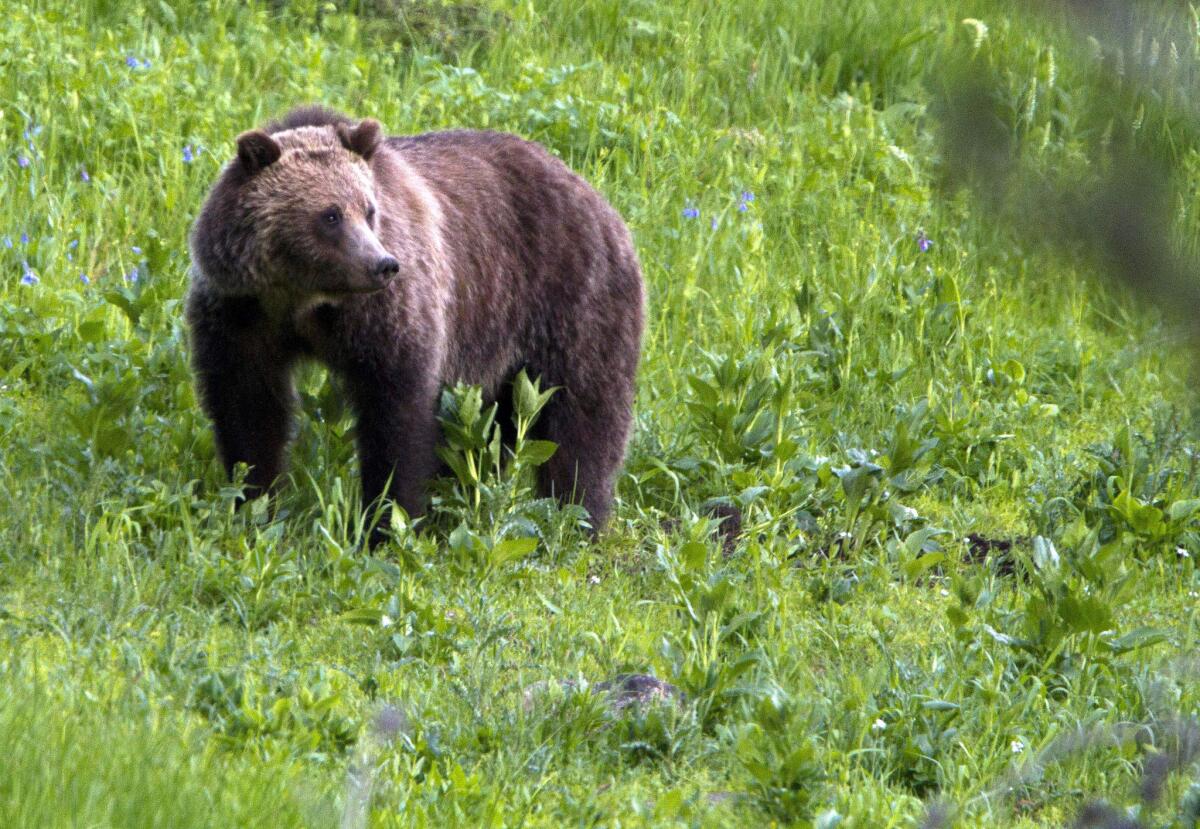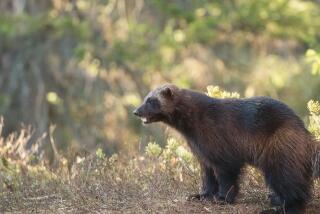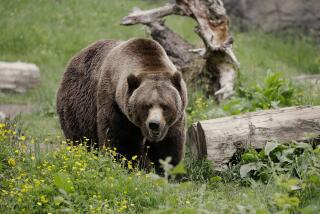Editorial: Planning the grizzly bear’s return

A grizzly bear roams near Beaver Lake in Yellowstone National Park.
- Share via
One of the sad consequences of the westward settlement of the United States was the near eradication of the grizzly bear. Once an iconic symbol of the American wild, the hulking brown bears were hunted, trapped and deemed fearsome, dangerous predators. In California, they were exterminated completely, remaining only as an image on the state flag and seal. By the time the federal government listed them as threatened in 1975 under the Endangered Species Act, there were only 136 grizzlies in the Greater Yellowstone Ecosystem, which ranges more than 22,000 square miles across Wyoming, Montana and Idaho.
------------
For the Record
April 24, 3:24 p.m.: An earlier version of this article incorrectly stated that the Greater Yellowstone Ecosystem covered more than 22,000 acres. It covers 22,000 square miles.
------------
Forty years later, thanks to federal government protection, there are 717 bears in the Yellowstone ecosystem. It is a population that has been relatively stable for more than a decade — one of the biggest recovery successes yet under the federal act. Now, the U.S. Fish and Wildlife Service has proposed delisting the grizzlies. It is an enormously controversial move, pitting scientists against scientists in a battle over whether the bears really have recovered. They will always need some measure of protection — the Fish and Wildlife Service says as much in its delisting proposal — but that can be provided by the states, according to the agency; the federal government no longer needs to be in total control.
Grizzly bears in the Yellowstone ecosystem (only a small fraction of which is within national parks) still face enormous challenges.
Grizzly bears in the Yellowstone ecosystem (only a small fraction of which is within national parks) still face enormous challenges. They have low genetic diversity because they’re isolated from other bear populations. They reproduce slowly. Two of their favorite food sources — cutthroat trout and the seeds from whitebark pine — have been decimated. Their population stopped growing significantly a decade ago. Some scientists believe federal officials are giving these factors short shrift, hurrying the delisting process in order to placate state wildlife officials eager to open hunting seasons.
But the work of scientists on the Interagency Grizzly Bear Study Team, a group of federal and state scientists, indicates that despite those challenges, the population has proven large and resourceful enough to sustain itself. Grizzly bears are adventurous omnivores that gorge themselves before denning for the winter on favorites such as plant seeds, moths (by the thousands) and elk. Grizzly study team leader Frank van Manen, without weighing in on the policy, says that this bear population has recovered.
While they’re listed, the bears receive federal protection; among other things, there may be no sport hunting. If they’re delisted, management reverts to state agencies which are expected to permit hunting.
Many protections would remain. The three states would be required to sign a wide-ranging, detailed conservation plan drawn up by the federal government that will require monitoring of the population and mortality data in perpetuity. The Fish and Wildlife Service would be able to relist the bears within weeks on an emergency basis if the states depart from the strict regulations or if the population declines.
Under the conservation plans, killing a bear for sport — or even killing a “nuisance bear” — would be highly regulated, and the number of allowable kills each year would be calculated on the previous year’s population and mortality figures. Most years that number will not exceed the low double digits and more likely would be in the single digits or even zero. With meticulous management and monitoring, the grizzly should be able to survive and thrive.
Follow the Opinion section on Twitter @latimesopinion and Facebook
More to Read
A cure for the common opinion
Get thought-provoking perspectives with our weekly newsletter.
You may occasionally receive promotional content from the Los Angeles Times.










